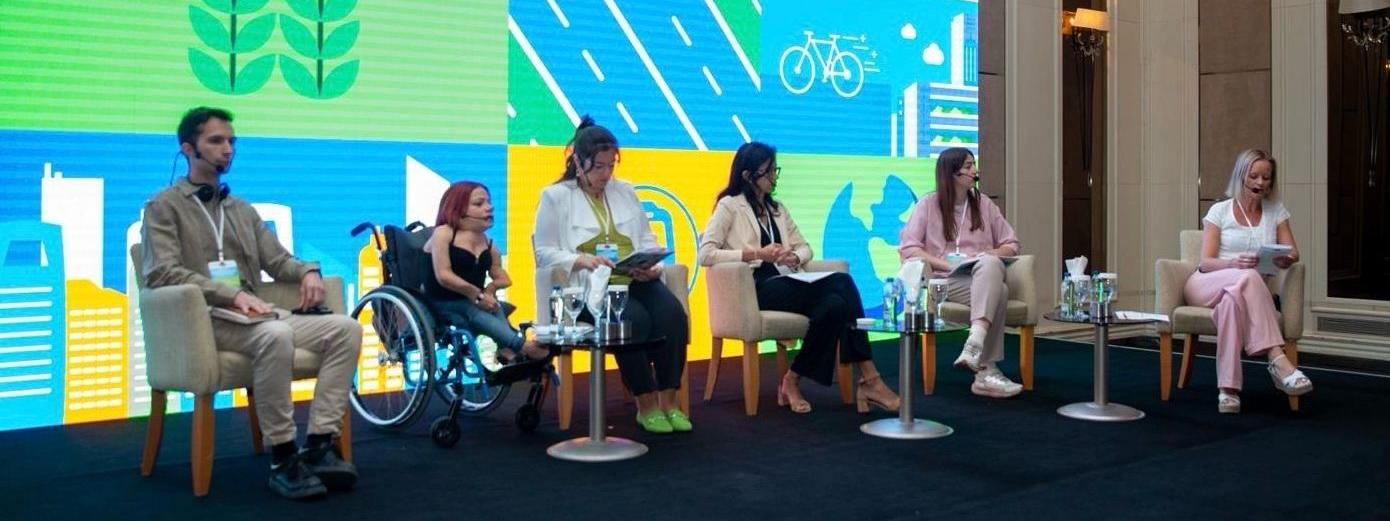On 7-8. July 2025, the International Conference on Sustainable Urban Mobility took place in Ankara, as part of the SUMP Türkiye Project. The project’s main objective is to promote a shift from individual transport to more sustainable, accessible, and inclusive mobility solutions at both national and urban levels. The event brought together over 300 participants, including representatives from public institutions, municipalities, academia, civil society organizations, the private sector, and national and international experts. It served as a key platform for discussing the future of sustainable mobility policies, sharing best practices and lessons learned, and strengthening dialogue among multiple stakeholders.
As part of the conference, EPF was invited to join a panel discussion on Building Equity into Everyday Mobility. The session was moderated by Karen Vancluysen, Secretary General of the POLIS Network, and featured the following speakers:
- Gemma Ellis, Clean Mobility Project Officer, Generation Climate Europe
- Dr. Isabel Cunha, Assistant Professor, ENTPE University of Lyon
- Esen Köse, Project Coordinator, SMALL (Shared Multimodal Mobility for All) project, Mpact vzw
- Laura Alčiauskaitė, Accessibility expert and independent researcher
- Jorge Morera, Board Member of the European Passengers’ Federation.

The conference’s discussions focused on accessibility in everyday mobility. Representing the European Passengers’ Federation (EPF), Jorge Morera emphasized that public transport – the backbone of sustainable mobility – must be designed to serve everyone, everywhere, at all times. He raised two central questions that sparked lively discussion among the panelists: How can we improve accessibility while promoting sustainability? And how can we foster a truly integrated mobility ecosystem?
Public Transport: Leading the Way Towards Sustainable & Accessible Cities
For public transport to truly serve as the backbone of mobility, accessibility and addressing transport poverty are paramount. Everyone, regardless of where they live or work, should have the opportunity to be a passenger. This means extending clean, energy-efficient public transport services not just to central city areas, but also peripheral and underserved areas.
Sustainable Urban Mobility Plans (SUMPs), the main topic of the conference, play a crucial role here. Urban planning and infrastructure design are fundamental to ensuring easy access to public transport stations and stops. SUMPs provide a strategic framework that supports the emergence of new kinds of public transport services, while ensuring no one is left behind in the transition to sustainable mobility. Ultimately, citizens must be offered a diverse portfolio of sustainable mobility options that can genuinely compete with private car use.
The Power of Multimodality: Connecting Journeys, Near and Far
The second key area of discussion revolved around how better integration of public transport and shared mobility can serve a broader group of users, extending beyond urban cores into suburban and rural areas. Achieving this requires a dual perspective: addressing both infrastructure and operations to enable multimodal services, and focusing on the passenger experience – how people perceive and utilize these services in their daily lives.
A key point emphasized was the importance of multimodal digital mobility services. This is a priority for EPF, particularly for long-distance travel. The goal is to create a seamless experience, integrating all steps – from ticketing to passenger rights – into a single, accessible, and transparent digital framework.
The discussion also highlighted the critical link between long-distance and local mobility. Local public transport plays a vital role in enabling first- and last-mile connectivity, which is essential for the success of Europe’s expanding high-speed rail network. As the European Commission continues to promote high-speed rail, it becomes even more important for urban mobility systems to align and complement these services – ensuring passengers can reach or depart from high-speed stations sustainably and efficiently.
Finally the need for multimodal hubs at all levels was discussed. While high-speed rail stations will increasingly serve as key multimodal interchange points, multimodal hubs should be distributed across the entire transport network – not just in large cities -, providing passengers with convenient and sustainable connections, everywhere they go.
Our ultimate goal is clear: to build a truly integrated public transport network that offers sustainable, convenient, and seamless access to all destinations – both near and far.


 Stay informed!
Stay informed!